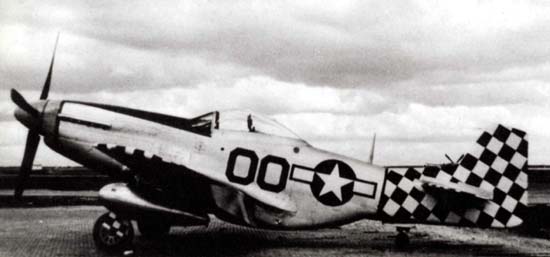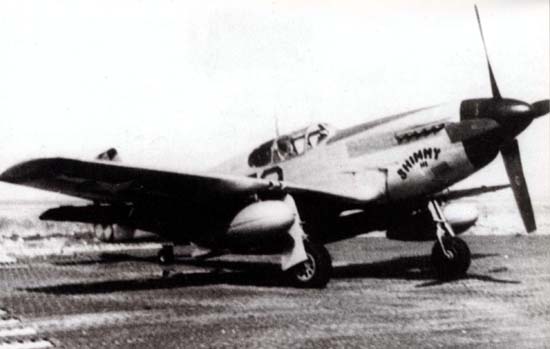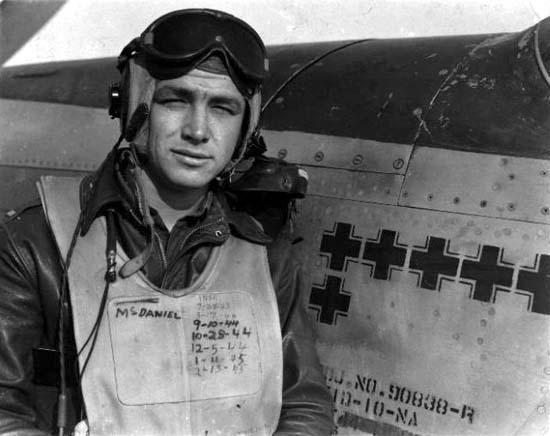_
|
HISTORY |
|
|
|
THE P-51 ERA (1943 - 1944) |
|
|
 |
|
PHOTO FROM " CHECKERTAILS" BY ERNEST R. McDOWELL |
|
Assigned to 318th FS
Commander Major James V. Toner, F-51D "00" displays a version of the
last paint scheme worn by Checkertail P-51's with the addition of
checkers on the the landing gear doors and the wingtips.
|
|
|
|
In May 1944, a second
aircraft transition took place for the Clan replacing the Groups rugged
P-47s with the famed P-51 Mustang accomplishing this while fulfilling
their combat requirements. With their new Mustangs, the squadron was
able to fly missions farther into enemy territory, and to escort bombers
from a pre-target rendezvous point, over the target, and well along the
course back to base. This meant that one group flying P-51s would be
able to supply the cover that had previously required two or three
groups flying P-47s.
|
|
|
|
Towards the end of May,
planning was underway for the Groups next mission, after 24-hour guard
was placed around the Commanding Officer’s tent, many in the group knew
this mission would not be routine. This talk was only intensified after
all pilots and selected ground personnel were asked to take passport
size photographs in civilian clothes. On June 2, the mystery surrounding
the mysterious mission began coming to light, a flight echelon
consisting of ground officers, crew chiefs, and clerks began deploying
to a heavy bomber base, as they arrived, they were briefed on their
mission, a mission codenamed "Operation Frantic".
|
|
|
|
Originally named
Operation Frantic Joe, the mission was a response to a request to the
15th Air Force by a desperate Joseph Stalin to help the Red Army in its
campaign in Romania. In exchange for the Fifteenth's assistance, Stalin
would allow American combat aircraft to be based at airfields within the
Soviet as during bombing raids German industrial regions in occupied
Silesia,
Hungary, and Romania. Before
it began, the mission was renamed "Operation Frantic" to avoid offending
the Soviet premier.
|
|
|
|
Sixty-four P-51s took
off from Lesina and escorted B-17s attacking Debreczen marshalling
yards, Hungary. After the attack, both fighters and bombers continued on
to Russian bases to complete the first
Italy-to Russia shuttle
mission of the war. Ground officers, crew chiefs, and clerks went to the
Russian bases in B-17s, and there performed the maintenance, operation,
and intelligence functions necessary to all missions.
|
|
|
 |
|
PHOTO FROM " CHECKERTAILS" BY ERNEST R. McDOWELL |
|
On 2 June 1944 Col Chet
Sluder led 64 P-51 Mustangs from 325th FG in the first effort to forward
deploy US bombers in Russia and Hungray in a mission titled "Operation
Frantic Joe". The P-51B Col Sluder used in that mission was "Shimmy III"
a/c #52.
|
|
|
|
The 318th Fighter
Squadron along with the other squadrons of the 325th Fighter Group flew
bomber escort missions against Rumanian airfields on 6th and 11th June
from the Russian bases. On the 6th of June 1944, 104 B-17s and 42 P-51
Mustangs from the 325th flew a mission attacking the airfield at Galati,
Romania, during the aerial battle, P-51's of the Green Dragons downed
six enemy fighters, while losing two of their P-51B's (42-103369,
42-103432). On June 11, all personnel and aircraft of the Checkertail
clan returned to their base Lesina, during the mission the Group only
lost two of the 234 B-17s it escorted over the German targets, killing
nine enemy aircraft in the process.
|
|
|
|
In the summer of 1944,
the Allied bombing campaign began to focus on German oil production. The
Clan escorted heavy bombers attacking either crude oil processing plants
in Rumania
or synthetic plants throughout Germany,
Czechoslovakia, Austria, or Hungary. A second priority was the
means the Germans would use to transport the crude, the railroad
network, which received a lot of attention from Allied the bombers and
strafing fighters. To keep enemy air resistance at a minimum it was
necessary to fly an occasional fighter sweep or bomber mission against
enemy airfields.
|
|
|
|
On 28 June 1944, 40
Mustangs of the 325th set out take the fight to the enemy seeking
"targets of opportunity" over
Bucharest,
Rumania. In the
fighter sweep mission, the Mustangs faced forty-seven enemy aircraft
destroying seventeen, a 318th pilot, F/O Robert H. Brown, led the Group
in kills during the mission with three, other Dragon pilots downed
another four.
|
|
|
 |
|
PHOTO FROM " CHECKERTAILS" BY ERNEST R. McDOWELL |
|
During the 318ths P-51 era,
the squadron flew three models of the Mustang, P-51B, P-51C & P-51D's.
|
|
|
|
What some called "an
example of courage and skill" from the members of the 325th occurred
during a not so routine mission escorting of B-24s on their way to
Bucharest on 31 July 1944. Sixteen of a package of forty-five
Checkertail P-51's broke away to face 45 Me-109s and FW-190s heading to
intercept the bomber force. The enemy fighters tried to lure the
attacking P-51 by performing "Lufbery
Circle" a defensive tactic developed by
Gervais Raoul Lufbery a French-American fighter pilot and flying ace in
World War I. In Lufbery Circle
(also known as Turn Fight or the Knife Fight) where fighters form a
horizontal circle so each plane would theoretically protect the plane in
front and receive protection from behind, the attacking fighter would be
unable to engage a member of the formation without coming under fire
himself.
|
|
|
|
The P-51s dived through
the circle and fought furiously destroying eighteen enemy fighters with
1 probable kill and 12 damaged. At the end of the fight, the Green
Dragons proved to be a formidable foe, the 318th scoreboard for the
mission sixteen kills. 318th pilot Lt. Harry A. Parker with four Me-10
kills (and six fighters damaged) Lt. Benjamin H. Emmert with three
Me-109 kills (and five fighters damaged) , Lt. Phillip Sangermano with
three Me-109 kills, Lieutenants John Reynolds, William Pomerantz, and
Vernier A. Goodman each with two kills apiece.
|
|
|
|
On 23 August 1944, the
Group was assigned to escort B-24s of the 461st BW on their way to bomb
the Markersdorf Airdrome, St. Polten,
Austria. During the mission more than seventy
ME-109s attacked the formation between Lake Balaton and the target, the 318th met the enemy
scoring nine kills. On the next day in a flight of 40 German
aircraft, the Clan encountered a familiar foe, a captured P-51, painted
black with yellow stripes around the wings. The attempt to confuse the
Dragons did not work, Lieutenants Harry A. Parker and Paul M.
Wipperfurth each killed one ME-109 apiece, and 318th Ace Lt. Robert H.
Brown would bag his seventh and last kill, a FW 190.
|
|
|
|
In a 5 November 1944
mission, after an escorting B-17s to the Venna Florisdorf oil refineries
on 5 November 1944, eight ME-109s engaged a flight of Checkertail P-51s
in the skies around the southern edge of Lake Balaton. Green Dragon
pilot Capt Oscar "Ockie" J Rau received a kill on his first match-up
with a ME-109, but his day had only just begun. After his first
engagement, Rau noticed that his flight leader was in battle with three
ME-109s, as he arrived on scene, he engaged and downed one of enemy
airplanes. He then went after the second of the three aggressors and won
the battle getting him kill number three. A moment later, Capt Rau's
wingman was in trouble, the Captain moved to keep the bandit of his
partner's tail, and downed number four. During the fight Lt. Bob Newell
and Maj Norman L. McDonald (an Ace that would later become the 318th
Commander) each received one kill apiece.
|
|
|
|
For his for
extraordinary heroism and unquestionable valor in aerial combat,
Lt Oscar J Rau was The Distinguished Service Cross, the second highest
award that can be awarded to a member of the
United States Army, for extreme gallantry and risk of life in actual
combat with an armed enemy force.
|
|
|
 |
|
PHOTO FROM " CHECKERTAILS" BY ERNEST R. McDOWELL |
|
SHU-SHU P-51D # 59 flown by
318 Commander Maj. Norman McDonald displays a smaller version of the
325th FG markings found on their P-51's. During his assignment with the
318th, Maj. McDonald added four kills to his seven kills earned with the
52nd Fighter Group making him a Double Ace.
|
|
|
|
During the lengthy stay
at Lesina Airfield, command of the 318th changed hands three times.
Captain Roy B. Hogg succeeded Lt. Col. James V. Toner, Jr. on 8 May
1944, who was appointed as Deputy Commander of the 325th Fighter Group.
On completing his tour of missions, Captain Roy B. Hogg was followed by
Major Sheldon W. Farnham who assumed command on 23 July 1944. The
command was changed again when Major Sheldon W. Farnham was transferred
to Group operations on 26 November 1944, and Major Norman L. McDonald
was placed in command.
|
|
The 318th remained at
Lesina longer than at any other base. Many things occurred during the
more than 11 months spent there, but it will best be remembered for very
rainy conditions that made life miserable, and sometimes dangerous
operationally considering that the muddy runway was built on a hillside.
|
|
Early in March 1945 the
318th moved again by air to Rimini Airdrome at Miramare, Italy. Living
conditions were much improved for the squadron; with squadron personnel
living in abandon buildings instead of the usual, US Army issued tents.
Squadron billets, surrounded by the town and was very close to the
Adriatic Sea, was located a good distance from their
airfield. To help personnel move between the living quarters and the
airfield, an hourly bus service was established.
|
|
On a 14 March 1945
escort mission, one P-51 experienced oxygen system problems and was
forced to pull out of formation, piercing the clouds, he was met by four
ME-109s on the prowl. After hearing the call for assistance, a large
portion of the flight dropped down to help their comrade, one pilot, Lt
Gordon H McDaniel found a line of eight or nine ME-109s. McDaniel began
a tail-end attack that resulted in the Lieutenant becoming an Ace adding
five kills to his one previous. By the end of the fight, 318th pilots
outnumbered better than two to one destroyed 18 probably destroyed one,
and damaged two FW-190s.
|
|
|
 |
|
PHOTO FROM ace1945.com |
|
Ace in a day Lt Gordon "Mac"
McDaniel is pictured with his 5 kills painted on his P-51D "Mary Mac" #
40.
|
|
|
|
Operations from
Rimini
Airdrome continued until 2 April when the squadron moved back to
Mondolfo Airfield, which was its last combat base in the
Mediterranean Theater of Operations. On the
same day of the move, after knocking out a train and damaging some
freight cars, the 325th ran into fifteen ME-109s, Maj McDonald shot down
two with Lt. George E. Amedro killing one. On the 4th, five trains
and five rail cars were destroyed in the Munich-Linz-Regensburg area;
the squadron engaged six FW-190s, Lt. Walter K. Selenger killed two,
Lieutenants William E. Aron, Lester F. Seevers, killing one each.
|
|
On 10 April, after a
Group freelance mission, two flights of 318th P-51s would remain over in
the Regensburg-Linz target area an extra hour one hour beyond the
required time seeking targets of opportunity, this came in the form of
German FW-190s. Six pilots (Major Norman L. McDonald, Lieutenants
William E. Aron, Richard D. Christman, Hibbard V Forsyth, James A.
Leonard, Jr., and Joe E. Mason) would attain the Green Dragons last
aerial victories of the War. The 318th would see 140 of its pilots
accounting for 176 victories between their first kill (17 April 1943)
through their last (10 April 1945).
|
|
On 7 May 1945, hours
before the end of the war in Europe the 325th flew its last combat
sortie, an mission escorting Halifax bombers of the Royal Air Force's
148 Squadron, when the propellers of the five P-51's came to a halt, the
war ended for the Checkertail Clan.
|
|
|
|
Final record for the
325th Fighter Group in the P-51:
- 342 missions
- 10,596 sorties
- 45,370 combat
hours
- 246 aerial victories
- 75 losses
|
|
From 17 April 1943 to 7
May 1945, the squadrons of the 325th Fighter Group contributed to a very
impressive combat efficiency, below you will find some of the notable
facts:
- 567 missions
- 18,212 sorties
- 70,772 combat
flying hours
- 27 Aces with 201
kills
- 537 aircraft destroyed in the
air (confirmed)
- 60 aircraft destroyed in the
air (probable)
- 89 aircraft damaged in the air
(confirmed)
- 250 aircraft damaged on the
ground (confirmed)
- 264 locomotives destroyed on
the ground (confirmed)
- 137 locomotives destroyed on
the ground (probable)
- 159 motor transports on the
ground (confirmed)
- 101 motor transports on the
ground (probable)
- 148 freight & oil cars
destroyed on the ground (confirmed)
- 995 freight & oil cars
destroyed on the ground (proabable)
|
|
|
|
Next Page: World War II Inactivation
|
|
|
|
|
 |
|